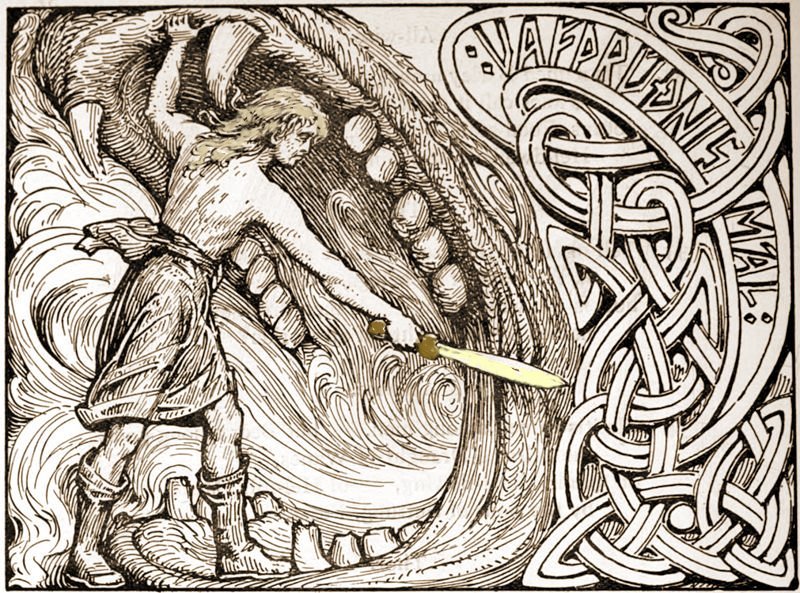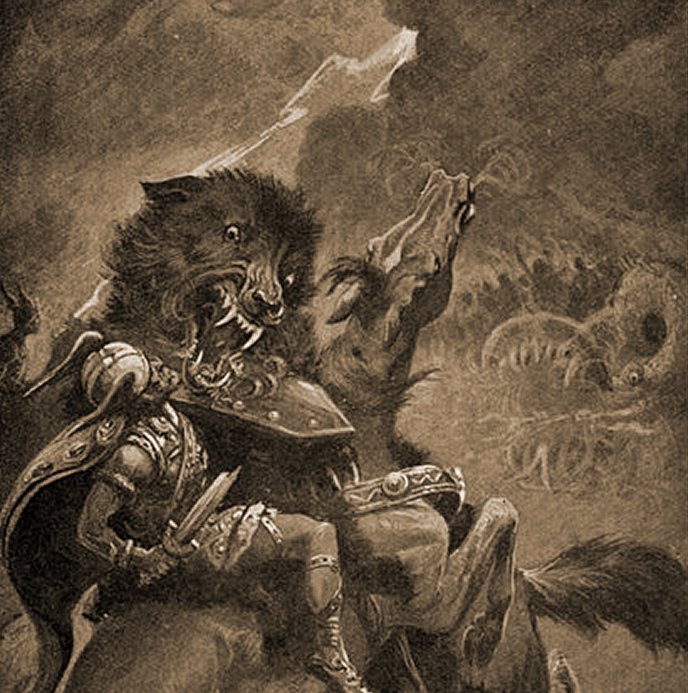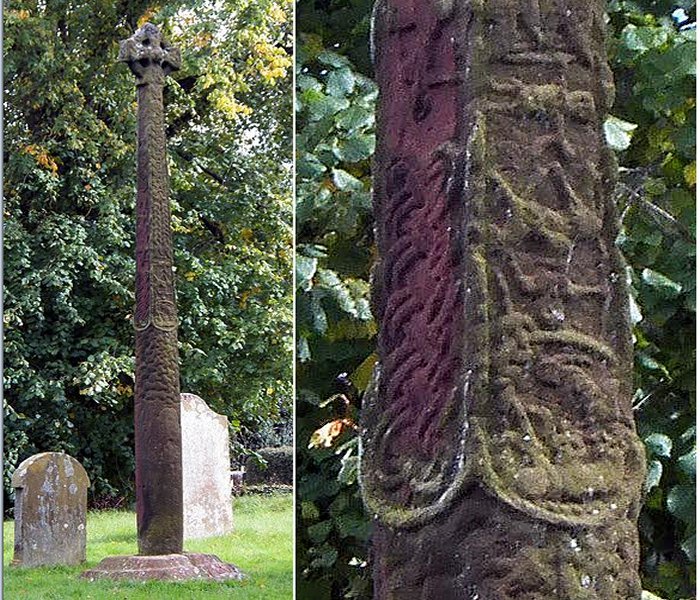Fenrir Killed At Ragnarok By Vidar Who Avenged His Father Odin’s Death
A. Sutherland - AncientPages.com - In Norse mythology, Vidar (in Old Norse: Vidarr – “wide ruler”) was famous for his silence.
He was one of the respected gods among the Aesir and one of the two gods associated with vengeance (the other was Vali, his half-brother). Vidar was also a very brave and fierce warrior who did not like to speak much and boast.
The god Víðarr stands in the jaws of Fenrir and swings his sword. The list of illustrations in the book's front matter gives this one the title Vidar (motive from the Gosforth Cross). Credit: W.G. Collingwood (1854 - 1932) – Public Domain
He possessed an enormous strength, which was only surpassed by Thor, and the Aesir gods often depended on him in times of trouble.
Vidar – “the silent god,” is foretold to avenge his father's death by killing the wolf Fenrir at Ragnarok. This god is attested in several sources, like Snorri Sturluson "Edda" and his "Prose Edda" books Gylfaginning and Skáldskaparmál. He is also mentioned in the Poetic Edda, the Icelandic medieval manuscript known as the Codex Regius. The Codex Regius is considered the most important source of Norse mythology and Germanic heroic legends.
In our earlier article, we were acquainted with the evil Fenrir (“bog dweller”), who had to feed on the bodies of the dead. Born in the Iron Forest (Járnviðr , Järnwidur), located on the border of Utgard and Midgard, Fenrir (or Fenris) was one of three terrible monster children of the trickster god Loki. He was born in the likeness of a gigantic wolf whose eyes and nostrils spewed out a fire.
His mother was the giantess and witch, Angrboda, who had two other terrible children, Hel, ruler of Niflheim, the land of the dead, and the Midgard Serpent, Jormungand, a hideous, venom-spewing serpent
These two – not exactly friendly creatures - were siblings of Fenrir.
Fenrir, the monster-wolf, and the god Odin in a fight. Image credit: Dorothy Hardy (fl. 1891 - 1925) via Wikipedia
Vidar’s father was the great god Odin, and his mother, the friendly giantess Grid. His home was called Vidi (Vide or Landvidi), a peaceful and silent place full of tall grasses, growing saplings, and wildflowers, where he rides and exercises his spear.
In the saga Grímnismál, Odin describes the halls of many gods, including that of his son Vidar:
“…Brushwood grows and high grass
widely in Vidar's land
and there the son proclaims on his horse's back
that he's keen to avenge his father..”.
Hero Vidar Depicted On Stone Cross
God Vidar was so admired that in the 9th century, he was depicted on a stone cross in the English city of Gosforth in Cumbria, England. On the cross, he fights against Fenrir, the wolf, immediately after he devoured his father Odin.
Gosforth cross; the tallest Viking cross in England. In the graveyard of the parish church of Gosforth, Cumbria. Image credit; Doug Sim/Wikipedia
The Gosforth Cross has intricate carvings depicting characters and scenes from Norse mythology. These include the god Heimdallr holding his horn; the god Vidar tearing the jaws of the wolf Fenrir; Thor's failed attempt to catch Jormungand, the Midgard Serpent, and Loki, the trickster god.
Deadly Encounter With Fenrir
One day in the future, the god Vidar must leave his quiet and peaceful land to fight at Ragnarok, “the darkness of the gods”, the coming destruction of the world, whose inevitability is impossible to fight with.
He had to face the evil monster, Fenrir, and defeat him, so it happened.
That day, Vidar leaped from his horse and attacked Fenrir to avenge his father, Odin. He stepped down with one foot on the lower jaw of Fenrir, grabbing his upper jaw in one hand and tearing his mouth apart. Finally, Fenrir was dead.
Tradition has it that Vidar wore a special shoe or boot that had been made from leather pieces he saved throughout all time.
Another version of the myth says that it was Vidar's mother, Grid made the shoe for Vidar.
Vidar, “the silent god,” was one of the few gods who survived Ragnarok and became one of the rulers of the new world.
Updated on March 1, 2023
Written by – A. Sutherland - AncientPages.com Senior Staff Writer
Copyright © AncientPages.com All rights reserved. This material may not be published, broadcast, rewritten or redistributed in whole or part without the express written permission of AncientPages.com
More From Ancient Pages
-
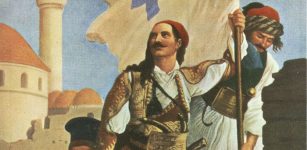 Horrible Ancient Massacre On The Island Of Chios Led To Greek Independence
Featured Stories | Jun 29, 2018
Horrible Ancient Massacre On The Island Of Chios Led To Greek Independence
Featured Stories | Jun 29, 2018 -
 On This Day In History: Edgar Allan Poe Known For Tales Of Mystery And Macabre Was Born – On Jan 19, 1809
News | Jan 19, 2017
On This Day In History: Edgar Allan Poe Known For Tales Of Mystery And Macabre Was Born – On Jan 19, 1809
News | Jan 19, 2017 -
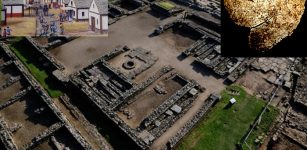 1,400-Year-Old Christian Chalice With Etched Symbols Found In Rubble At Vindolanda Fort, Britain
Artifacts | Sep 1, 2020
1,400-Year-Old Christian Chalice With Etched Symbols Found In Rubble At Vindolanda Fort, Britain
Artifacts | Sep 1, 2020 -
 Cueva de Ardales – Rock Art Cave In Spain Was Used By Ancient Humans For More Than 50,000 Years
Archaeology | Jun 1, 2022
Cueva de Ardales – Rock Art Cave In Spain Was Used By Ancient Humans For More Than 50,000 Years
Archaeology | Jun 1, 2022 -
 DNA Breakthrough – New Human Gene Cluster Sequence Discovered
Evolution | Nov 24, 2023
DNA Breakthrough – New Human Gene Cluster Sequence Discovered
Evolution | Nov 24, 2023 -
 Artifacts And Long History Of Unguja Island – Ancient Humans Impact Island’s Environment
Archaeology | Mar 5, 2022
Artifacts And Long History Of Unguja Island – Ancient Humans Impact Island’s Environment
Archaeology | Mar 5, 2022 -
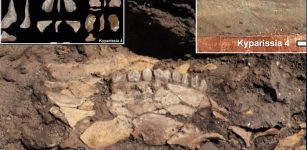 Greek Discovery Of Stone Tools In Megalopolis Area Pushes Back Greece’s Archaeological Record Up To 250,000 Years
Archaeology | Jun 2, 2023
Greek Discovery Of Stone Tools In Megalopolis Area Pushes Back Greece’s Archaeological Record Up To 250,000 Years
Archaeology | Jun 2, 2023 -
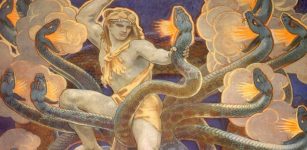 Hydra Greek Monster: Fearsome Multi-Headed Dragon That Inhabited Swamps Of Lerna
Featured Stories | Sep 20, 2019
Hydra Greek Monster: Fearsome Multi-Headed Dragon That Inhabited Swamps Of Lerna
Featured Stories | Sep 20, 2019 -
 Hidden Ancient Citadel In The Mayan City Of Tikal Discovered By LIDAR
Archaeology | Sep 28, 2021
Hidden Ancient Citadel In The Mayan City Of Tikal Discovered By LIDAR
Archaeology | Sep 28, 2021 -
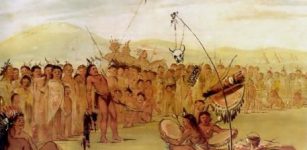 Native American Sun Dance: Important Ceremony Of The Plains Indians Of North America
Ancient History Facts | May 20, 2016
Native American Sun Dance: Important Ceremony Of The Plains Indians Of North America
Ancient History Facts | May 20, 2016 -
 Undeciphered Ancient Symbols On Boulders In Pennsylvania And New England Could Be An Ancient Diary Of Forgotten Civilizations And Events
Featured Stories | Jul 4, 2024
Undeciphered Ancient Symbols On Boulders In Pennsylvania And New England Could Be An Ancient Diary Of Forgotten Civilizations And Events
Featured Stories | Jul 4, 2024 -
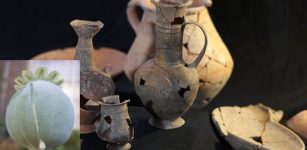 Opium Residue Discovered In 3,500-Year-Old Pottery Offers Evidence The Drug Was Used In Ancient Burial Rituals
Archaeology | Sep 20, 2022
Opium Residue Discovered In 3,500-Year-Old Pottery Offers Evidence The Drug Was Used In Ancient Burial Rituals
Archaeology | Sep 20, 2022 -
 Discovery Of World’s Oldest Fortresses Reshapes Our Understanding Of Hunter–Gatherers
Archaeology | Dec 7, 2023
Discovery Of World’s Oldest Fortresses Reshapes Our Understanding Of Hunter–Gatherers
Archaeology | Dec 7, 2023 -
 The Black Obelisk Of Shalmaneser III – Great Assyrian Ruler
Artifacts | Dec 29, 2016
The Black Obelisk Of Shalmaneser III – Great Assyrian Ruler
Artifacts | Dec 29, 2016 -
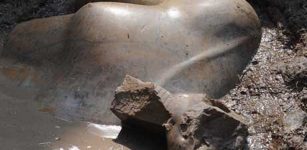 Two 19th Dynasty Royal Statues Unearthed At Ancient Site Of Heliopolis, Cairo, Egypt
Archaeology | Mar 11, 2017
Two 19th Dynasty Royal Statues Unearthed At Ancient Site Of Heliopolis, Cairo, Egypt
Archaeology | Mar 11, 2017 -
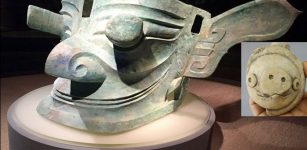 Old Clay Pig Figurine And A 5,000-Year-Old Settlement Found Near Mysterious Sanxingdui Ruins, China
Archaeology | Jul 30, 2020
Old Clay Pig Figurine And A 5,000-Year-Old Settlement Found Near Mysterious Sanxingdui Ruins, China
Archaeology | Jul 30, 2020 -
 Prehistoric Humans Recycled Old Stone Tools To Preserve The Memory Of Their Ancestors
Archaeology | Mar 17, 2022
Prehistoric Humans Recycled Old Stone Tools To Preserve The Memory Of Their Ancestors
Archaeology | Mar 17, 2022 -
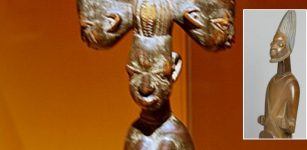 Shango: Powerful Thunder God And Symbol Of Kingship Among Yoruba People Of West Africa
African Mythology | Mar 4, 2019
Shango: Powerful Thunder God And Symbol Of Kingship Among Yoruba People Of West Africa
African Mythology | Mar 4, 2019 -
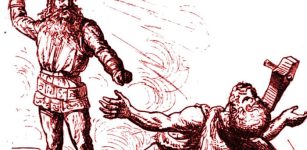 Giant Hrungnir Who Lost The Race And Engaged In A Deadly Duel With Mighty Thor In Norse Mythology
Featured Stories | Sep 19, 2018
Giant Hrungnir Who Lost The Race And Engaged In A Deadly Duel With Mighty Thor In Norse Mythology
Featured Stories | Sep 19, 2018 -
 How Extensively Did Early Farmers Utilize Europe’s Rich Forests For Raising Their Livestock?
Archaeology | Nov 13, 2024
How Extensively Did Early Farmers Utilize Europe’s Rich Forests For Raising Their Livestock?
Archaeology | Nov 13, 2024

